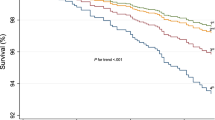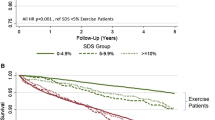Abstract
Background
Patients who achieve ≥ 10 METS during exercise SPECT myocardial perfusion imaging (MPI) have very low rates of significant ischemia and major adverse cardiac events (MACE). It is unknown how many older adults can achieve ≥ 10 METS, and if low risk extends to this subgroup.
Methods and results
We examined the workload achieved, prevalence and predictors of ischemia, and MACE (cardiac death, non-fatal MI, late revascularization) in a cohort of 382 patients ≥ 65 years of age who underwent exercise 99mTc SPECT MPI. The cohort was 64.4% male and 36.9% had known coronary artery disease (CAD). All achieved ≥ 85% of maximum age-predicted heart rate. A workload of ≥ 10 METS was achieved in 25.4%; 50.3% attained 7-9 METS, and 24.4% reached < 7 METS. There was a stepwise decrease in prevalence of any ischemia and significant ischemia (≥ 10% of the left ventricle (LV)) as workload increased (P = 0.037). Patients achieving ≥ 10 METS had a 3.1% prevalence of ≥ 10% LV ischemia (1.2% in those without ST depression). Cardiac death and MACE rates in the ≥ 10 METS subgroup were 0.6%/year and 2.6%/year over a median 7.0 years of follow-up.
Conclusions
A substantial proportion of older adults who undergo exercise SPECT MPI can achieve ≥ 10 METS. This subgroup has low rates of significant LV ischemia and MACE. The favorable diagnostic and prognostic implications of achieving a high workload in an older adult population suggest it is feasible, with certain exceptions, to include this subgroup in workload-based strategies of provisional imaging.





Similar content being viewed by others
Abbreviations
- CAD:
-
Coronary artery disease
- CV:
-
Cardiovascular
- ECG:
-
Electrocardiography
- LV:
-
Left ventricular
- MAPHR:
-
Maximum age-predicted heart rate
- METS:
-
Metabolic equivalents
- MI:
-
Myocardial infarction
- MPI:
-
Myocardial perfusion imaging
- SPECT:
-
Single photon-emission computed tomography
References
Morise AP, Jalisi F. Evaluation of pretest and exercise test scores to assess all-cause mortality in unselected patients presenting for exercise testing with symptoms of suspected coronary artery disease. J Am Coll Cardiol 2003;42:842 50.
Snader CE, Marwick TH, Pashkow FJ, Harvey SA, Thomas JD, Lauer MS. Importance of estimated functional capacity as a predictor of all-cause mortality among patients referred for exercise thallium single-photon emission computed tomography: Report of 3,400 patients from a single center. J Am Coll Cardiol 1997;30:641-8.
Kodama S, Saito K, Tanaka S, Maki M, Yachi Y, Asumi M, et al. Cardiorespiratory fitness as a quantitative predictor of all-cause mortality and cardiovascular events in healthy men and women: A meta-analysis. JAMA 2009;301:2024-35.
Goraya TY, Jacobsen SJ, Pellikka PA, Miller TD, Khan A, Weston SA, et al. Prognostic value of treadmill exercise testing in elderly persons. Ann Int Med 2000;132:862-70.
Faselis C, Doumas M, Pittaras A, Narayan P, Myers J, Tsimploulis A, et al. Exercise capacity and all-cause mortality in male veterans with hypertension aged >/=70 years. Hypertension 2014;64:30-5.
Lee DS, Verocai F, Husain M, Al Khdair D, Wang X, Freeman M, et al. Cardiovascular outcomes are predicted by exercise-stress myocardial perfusion imaging: Impact on death, myocardial infarction, and coronary revascularization procedures. Am Heart J 2011;161:900-7.
Fine NM, Pellikka PA, Scott CG, Gharacholou SM, McCully RB. Characteristics and outcomes of patients who achieve high workload (>/=10 metabolic equivalents) during treadmill exercise echocardiography. Mayo Clinic Proc 2013;88:1408-19.
Kokkinos P, Myers J, Faselis C, Panagiotakos DB, Doumas M, Pittaras A, et al. Exercise capacity and mortality in older men: A 20-year follow-up study. Circulation 2010;122:790-7.
Bourque JM, Holland BH, Watson DD, Beller GA. Achieving an exercise workload of > or = 10 metabolic equivalents predicts a very low risk of inducible ischemia: Does myocardial perfusion imaging have a role? J Am Coll Cardiol 2009;54:538-45.
Bourque JM, Charlton GT, Holland BH, Belyea CM, Watson DD, Beller GA. Prognosis in patients achieving >/=10 METS on exercise stress testing: Was SPECT imaging useful? J Nucl Cardiol 2011;18:230-7.
Duvall WL, Levine EJ, Moonthungal S, Fardanesh M, Croft LB, Henzlova MJ. A hypothetical protocol for the provisional use of perfusion imaging with exercise stress testing. J Nucl Cardiol 2013;20:739-47.
Duvall WL, Savino JA, Levine EJ, Hermann LK, Croft LB, Henzlova MJ. Prospective evaluation of a new protocol for the provisional use of perfusion imaging with exercise stress testing. Eur J Nucl Med Mol Imaging 2015;42:305-16.
Watson DD, Smith WH 2nd. The role of quantitation in clinical nuclear cardiology: The University of Virginia approach. J Nucl Cardiol 2007;14:466-82.
Mark DB, Shaw L, Harrell FE Jr, Hlatky MA, Lee KL, Bengtson JR, et al. Prognostic value of a treadmill exercise score in outpatients with suspected coronary artery disease. N Engl J Med 1991;325:849-53.
Gibbons RJ, Balady GJ, Bricker JT, Chaitman BR, Fletcher GF, Froelicher VF, et al. ACC/AHA 2002 guideline update for exercise testing: summary article. A report of the American College of Cardiology/American Heart Association Task Force on Practice Guidelines (Committee to Update the 1997 Exercise Testing Guidelines). J Am Coll Cardiol 2002;40:1531-40.
Gulati M, Pandey DK, Arnsdorf MF, Lauderdale DS, Thisted RA, Wicklund RH, et al. Exercise capacity and the risk of death in women: The St James Women Take Heart Project. Circulation 2003;108:1554-9.
Hachamovitch R, Hayes SW, Friedman JD, Cohen I, Berman DS. Comparison of the short-term survival benefit associated with revascularization compared with medical therapy in patients with no prior coronary artery disease undergoing stress myocardial perfusion single photon emission computed tomography. Circulation 2003;107:2900-7.
Hachamovitch R, Rozanski A, Hayes SW, Thomson LE, Germano G, Friedman JD, et al. Predicting therapeutic benefit from myocardial revascularization procedures: Are measurements of both resting left ventricular ejection fraction and stress-induced myocardial ischemia necessary? J Nucl Cardiol 2006;13:768-78.
Myers J, Prakash M, Froelicher V, Do D, Partington S, Atwood JE. Exercise capacity and mortality among men referred for exercise testing. N Engl J Med 2002;346:793-801.
Peterson PN, Magid DJ, Ross C, Ho PM, Rumsfeld JS, Lauer MS, et al. Association of exercise capacity on treadmill with future cardiac events in patients referred for exercise testing. Arch Int Med 2008;168:174-9.
Morris CK, Morrow K, Froelicher VF, Hideg A, Hunter D, Kawaguchi T, et al. Prediction of cardiovascular death by means of clinical and exercise test variables in patients selected for cardiac catheterization. Am Heart J 1993;125:1717-26.
Bhat A, Desai A, Amsterdam EA. Usefulness of high functional capacity in patients with exercise-induced ST-depression to predict a negative result on exercise echocardiography and low prognostic risk. Am J Cardiol 2008;101:1541-3.
Beller GA, Bateman TM. Provisional use of myocardial perfusion imaging in patients undergoing exercise stress testing: A worthy concept fraught with challenges. J Nucl Cardiol 2013;20:711-4.
Bourque JM, Beller GA. Value of exercise ECG for risk stratification in suspected or known CAD in the era of advanced imaging technologies. JACC Cardiovasc Imaging 2015;8:1309-21.
Rozanski A, Cohen R, Uretsky S. The coronary calcium treadmill test: A new approach to the initial workup of patients with suspected coronary artery disease. J Nucl Cardiol 2013;20:719-30.
Chang SM, Nabi F, Xu J, Pratt CM, Mahmarian AC, Frias ME, et al. Value of CACS compared with ETT and myocardial perfusion imaging for predicting long-term cardiac outcome in asymptomatic and symptomatic patients at low risk for coronary disease: Clinical implications in a multimodality imaging world. JACC Cardiovasc Imaging 2015;8:134-44.
Shaw LJ. The exercise test is alive and well when coupled with coronary calcium scoring. JACC Cardiovasc Imaging 2015;8:145-7.
Disclosure
Dr. Jamieson Bourque has received research grant support from Astellas Pharma US Inc. Drs. Smith, Myc, Watson, and Beller have no conflicts of interest to disclose.
Author information
Authors and Affiliations
Corresponding author
Additional information
The authors of this article have provided a PowerPoint file, available for download at SpringerLink, which summarises the contents of the paper and is free for re-use at meetings and presentations. Search for the article DOI on SpringerLink.com.
An audio interview was held July 23, 2018 between Associate Editor, Fadi G. Hage, and Jamieson Bourque, co-author of this article. An audio file of the interview is available as an .mp3 download at the article webpage on SpringerLink.com, and can be found by searching for the article title or DOI.
Funding
NIH K-Award 5K23HL119620-02.
Electronic supplementary material
Below is the link to the electronic supplementary material.
Rights and permissions
About this article
Cite this article
Smith, L., Myc, L., Watson, D. et al. A high exercise workload of ≥ 10 METS predicts a low risk of significant ischemia and cardiac events in older adults. J. Nucl. Cardiol. 27, 1486–1496 (2020). https://doi.org/10.1007/s12350-018-1376-7
Received:
Accepted:
Published:
Issue Date:
DOI: https://doi.org/10.1007/s12350-018-1376-7




